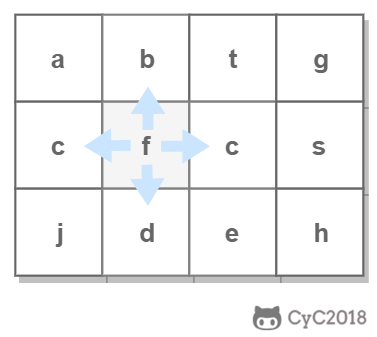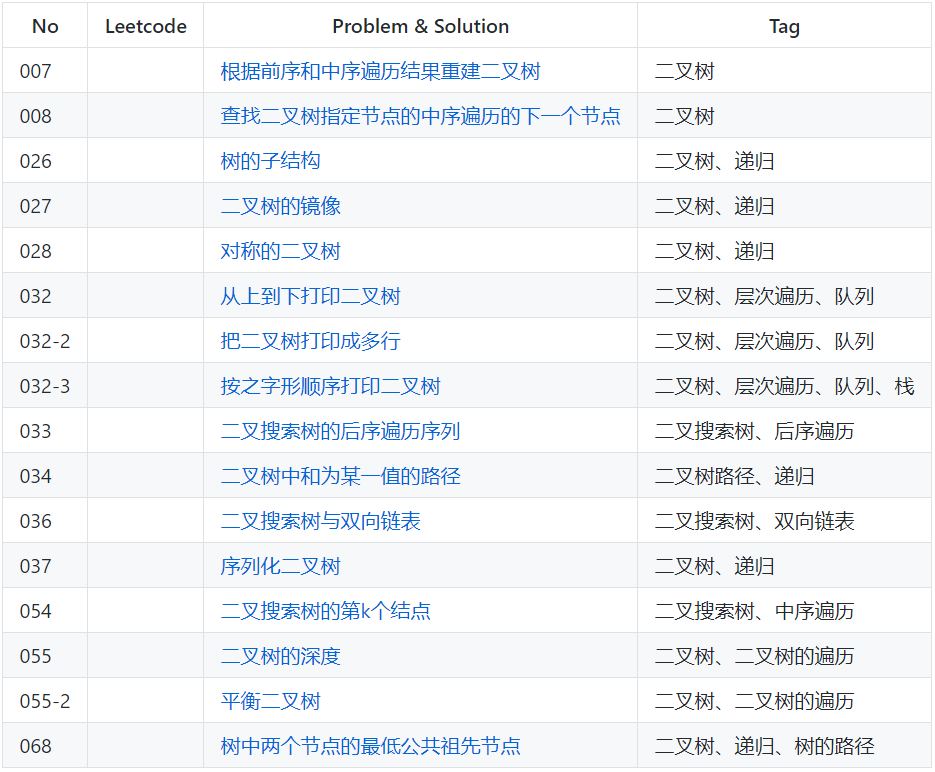引言:
LeetCode Top100 tags题解
P39数组中重复数字
要求时间复杂度 O(N),空间复杂度 O(1)。因此不能使用排序的方法,也不能使用额外的标记数组。对于这种数组元素在 [0, n-1] 范围内的问题,可以将值为 i 的元素调整到第 i 个位置上进行求解。以 (2, 3, 1, 0, 2, 5) 为例,遍历到位置 4 时,该位置上的数为 2,但是第 2 个位置上已经有一个 2 的值了,因此可以知道 2 重复:
思路
从哈希表的思路拓展,重排数组:把扫描的每个数字(如数字m)放到其对应下标(m下标)的位置上,若同一位置有重复,则说明该数字重复。

代码
1 | package swordforoffer; |
P44二维数组查找
解题思路
要求时间复杂度 O(M + N),空间复杂度 O(1)。其中 M 为行数,N 为 列数。该二维数组中的一个数,小于它的数一定在其左边,大于它的数一定在其下边。因此,从右上角开始查找,就可以根据 target 和当前元素的大小关系来缩小查找区间,当前元素的查找区间为左下角的所有元素。

1 | package swordforoffer; |
P51替换空格
题目
请实现一个函数,把字符串中的每个空格替换成”%20”。例如输入“We are happy.”,则输出“We%20are%20happy.”。
思路
首先要询问面试官是新建一个字符串还是在原有的字符串上修改,本题要求在原有字符串上进行修改。
若从前往后依次替换,在每次遇到空格字符时,都需要移动后面O(n)个字符,对于含有O(n)个空格字符的字符串而言,总的时间效率为O(n2)。
转变思路:先计算出需要的总长度,然后从后往前进行复制和替换,则每个字符只需要复制一次即可。时间效率为O(n)。
测试用例
- 字符串中无空格
- 字符串中含有空格(连续空格,空格在首尾等)
- 字符串为空字符串或者为null
1 | package swordforoffer; |
P59从尾到头输出链表
思路
结点遍历顺序只能从头到尾,但是输出的顺序却为从尾到头,是典型的“后进先出”问题,这就要联想到使用栈,从而也可以联想到使用递归。
测试用例
1.功能测试(单个结点链表,多个结点链表)
2.特殊输入测试(链表为空)
代码
1 | package swordforoffer; |
总结:
- 对于“后进先出”问题,要快速想到”栈“,也同时想到递归。
- 递归代码的写法,错了好几次。
P62重建二叉树
题目
输入某二叉树的前序遍历和中序遍历的结果,请重建出该二叉树。假设输入的前序遍历和中序遍历的结果中都不含重复的数字。例如输入前序遍历序列{1, 2, 4, 7, 3, 5, 6, 8}和中序遍历序列{4, 7, 2, 1, 5, 3, 8, 6},则重建出其二叉树并输出它的头结点。
思路
前序遍历第一个值就是根结点的值,根据该值在中序遍历的位置,可以轻松找出该根结点左右子树的前序遍历和中序遍历,之后又可以用同样方法构建左右子树,所以该题可以采用递归的方法完成。
代码
1 | package swordforoffer; |
P65二叉树的下一个节点
题目
给定一棵二叉树和其中的一个结点,如何找出中序遍历顺序的下一个结点? 树中的结点除了有两个分别指向左右子结点的指针以外,还有一个指向父结点的指针。
解题思路
① 如果一个节点的右子树不为空,那么该节点的下一个节点是右子树的最左节点;

② 若当前结点无右子树时,
- 若当前结点为其父结点的左子结点时,其下一个结点为其父结点;
- 若当前结点为其父结点的右子结点时,继续向上遍历父结点的父结点,直到找到一个结点是其父结点的左子结点(与① 中判断相同),该结点即为下一结点。

代码
1 | package swordforoffer; |
P68使用两个栈实现队列
思路
in 栈用来处理入栈(push)操作,out 栈用来处理出栈(pop)操作。一个元素进入 in 栈之后,出栈的顺序被反转。当元素要出栈时,需要先进入 out 栈,此时元素出栈顺序再一次被反转,因此出栈顺序就和最开始入栈顺序是相同的,先进入的元素先退出,这就是队列的顺序。

代码
1 | package swordforoffer; |
P74斐波那契数列
斐波那契数列

解题思路
如果使用递归求解,会重复计算一些子问题。例如,计算 f(4) 需要计算 f(3) 和 f(2),计算 f(3) 需要计算 f(2) 和 f(1),可以看到 f(2) 被重复计算了。

递归是将一个问题划分成多个子问题求解,动态规划也是如此,但是动态规划会把子问题的解缓存起来,从而避免重复求解子问题。
代码
1 | package swordforoffer; |
青蛙跳台阶问题
题目1:一只青蛙一次可以跳上1级台阶,也可以跳上2级。求该青蛙跳上一个n级的台阶总共有多少种跳法。
将跳法总数记为f(n),可以知道f(1)=1,f(2)=2。当n>2时,第一次跳1级的话,还有f(n-1)种跳法;第一次跳2级的话,还有f(n-2)种跳法,所以可以推得f(n)=f(n-1)+f(n-2),即为斐波那契数列。
题目2:一只青蛙一次可以跳上1级台阶,也可以跳上2级……它也可以跳上n级。求该青蛙跳上一个n级的台阶总共有多少种跳法。
解法1:
当n=1时,f(1)=1。
当n大于1时,归纳总结可知:跳上n级台阶,第一次跳1级的话,有f(n-1)种方法;第一次跳2级的话,有f(n-2)种方法……第一次跳n-1级的话,有f(1)种方法;直接跳n级的话,有1种方法,所以可以得到如下公式:
f(n) = f(n-1)+f(n-2)+……f(1)+1 (n≥2)
f(n-1) = f(n-2)+f(n-3)+…..f(1)+1 (n>2)
由上面两式相减可得,f(n)-f(n-1)=f(n-1),即f(n) = 2*f(n-1) (n>2)
最终结合f(1)和f(2),可以推得:f(n)=2^(n-1)
解法2:
假设跳到第n级总共需要k次,说明要在中间n-1级台阶中选出任意k-1个台阶,即C(n-1,k-1)种方法。
所以:跳1次就跳上n级台阶,需要C(n-1,0)种方法;跳2次需要C(n-1,1)种方法……跳n次需要C(n-1,n-1)种方法
总共需要跳C(n-1,0)+C(n-1,1)+C(n-1,2)+……C(n-1,n-1)=2^(n-1)种方法。
解法3:
除了必须到达最后一级台阶,第1级到第n-1级台阶都可以有选择的跳,也就是说对于这n-1个台阶来说,每个台阶都有跳上和不跳上2种情况,所以一共有2^(n-1)种方法。
1 | public int JumpFloorII(int target) { |
矩形覆盖问题
\题目:**用n个21的小矩形无重叠地覆盖一个2n的大矩形,总共有多少种方法?
当n = 1时,有一种方法。
当n = 2时,有两种方法。
当n >= 3时,和斐波那契数列类似。第一步竖着放,有f(n-1)种方法;第一步横着放,有f(n-2)种方法。所以f(n)=f(n-1)+f(n-2)。
小结
1.求n次方时,可以利用递归来降低时间复杂度
2.当遇到涉及n的问题时(类似青蛙跳台阶问题),注意f(n)与f(n-1)、f(n-2)等的关联,从而找出规律,进行合理建模。
3.return (int)Math.pow(2,target-1);
1) 转int类型
2)pow不是power
P82旋转数组查找最小值
思路
数组在一定程度上是排序的,很容易分析出:可以采用二分法来寻找最小数字。但是这里面有一些陷阱:
- 递增排序数组的本身是自己的旋转,则最小数字是第一个数字
- 中间数字与首尾数字大小相等,如{1,0,1,1,1,1}和{1,1,1,1,0,1},无法采用二分法,只能顺序查找。
代码
1 | package swordforoffer; |
P89矩阵中的路径
题目
请设计一个函数,用来判断在一个矩阵中是否存在一条包含某字符串所有字符的路径。路径可以从矩阵中任意一格开始,每一步可以在矩阵中向左、右、上、下移动一格。如果一条路径经过了矩阵的某一格,那么该路径不能再次进入该格子。例如在下面的3×4的矩阵中包含一条字符串“bfce”的路径(路径中的字母用下划线标出)。但矩阵中不包含字符串“abfb”的路径,因为字符串的第一个字符b占据了矩阵中的第一行第二个格子之后,路径不能再次进入这个格子。
A B T G
C F C S
J D E H
解题思路
使用回溯法(backtracking)进行求解,它是一种暴力搜索方法,通过搜索所有可能的结果来求解问题。回溯法在一次搜索结束时需要进行回溯(回退),将这一次搜索过程中设置的状态进行清除,从而开始一次新的搜索过程。例如下图示例中,从 f 开始,下一步有 4 种搜索可能,如果先搜索 b,需要将 b 标记为已经使用,防止重复使用。在这一次搜索结束之后,需要将 b 的已经使用状态清除,并搜索 c。

首先对所整个矩阵遍历,找到第一个字符,然后向上下左右查找下一个字符,由于每个字符都是相同的判断方法(先判断当前字符是否相等,再向四周查找),因此采用递归函数。由于字符查找过后不能重复进入,所以还要定义一个与字符矩阵大小相同的布尔值矩阵,进入过的格子标记为true。如果不满足的情况下,需要进行回溯,此时,要将当前位置的布尔值标记回false。(所谓的回溯无非就是对使用过的字符进行标记和处理后的去标记)
刷题类别:
二叉树
